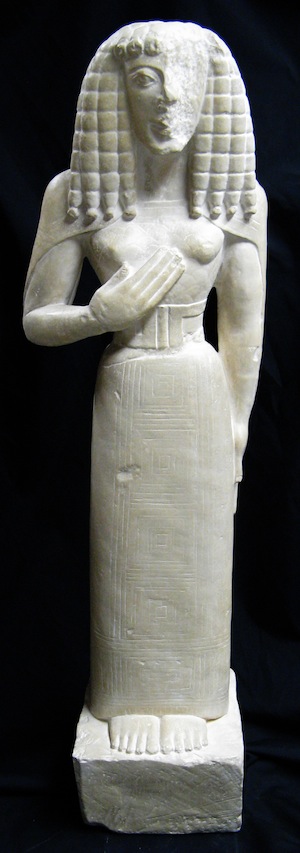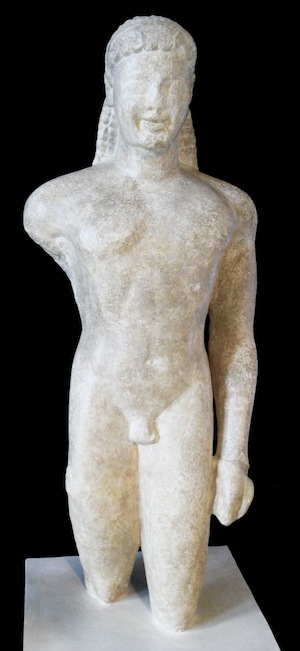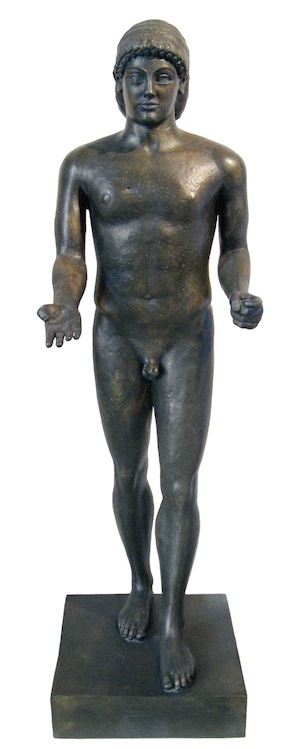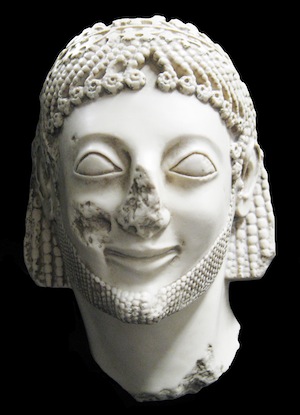During the Archaic period, Greek society had already sufficiently evolved along its own lines to create, through learned lessons and skills, a congruous art. An effort to achieve likeness in rendering the human figure is already apparent in the freestanding votive sculptures of young men, or kouroi. A glance at its Egyptian stylistic counterpart, the pharaoh, makes clear the kouros’ debt to, as well as departure from, this predecessor. The “archaic smile,” outstretched palm, clenched fist, and wooden posture of a striding figure are all stylistic devices.
The pottery painting styles generally corresponding to this period (1200-500 BC) differ greatly from the sculptural art mentioned above. Proto-Geometric painting, dating from the twelfth century, is characterized by austerity and precision with concentric circles and black areas. Geometric painting succeeded at the close of the tenth century and is characterized by zig-zag and meander patterns painted horizontally. In the late eighth century, due to influence from the east, floral and animal patterns, as well as increasingly naturalistic human forms (conciding with the development of Archaic sculpture) were introduced. By 600 BC, Black-Figure painting was predominant; by 530 BC, Red-Figure was the prevalent style.
Sculpture

Lady of Auxerre
Archaic Greek
replica
date of the original: c. 650-625 BC
provenance of the original: found in a vault in the Museum of Auxerre in 1909; now in the Louvre, Paris
description: Female statue on base. Left side of face heavily damaged, as well as damage on the left shoulder and along the back. Elongated hands and feet. Daedalic type; Greco-Cretan style. Plaster replica; limestone original. Height 76 cm, width 23 cm, depth 16 cm.
The Lady of Auxerre was named after the little Museum of Auxerre, a small city in the vicinity of Paris, where, in the 19th century, a Louvre curator sighted her in the vault of that museum. No documents or information of any sort were available concerning the circumstances of her arrival there.
It was decided she was a specimen of the so-called Daedalic type of eastern origin cultivated in the Greek world of the seventh century BC. Typical, in this respect, is her wig (which could also be Egyptian) and triangular face, while her dress is of the ancient Cretan type.

Kouros of Paros
Archaic Greek
replica: from the Louvre, Paris
date of the original: mid-6th century BC
provenance of the original: the island of Paros; now in the Louvre, Paris
description: Standing youth, arms at sides, left leg forward. Destroyed below the knees, right arm missing below shoulder. Left arm and right hand restored. Plaster replica; marble original. On base: height 129 cm, width 36 cm, depth 39 cm.
The Kouros of Paros was named after the site of his discovery and simply designated as kouros or young man for lack of more precise information. He can be approximately dated in the mid sixth century BC, the Archaic Period, the beginning of life-size--as well as colossal and monumental--Greek statuary.
However, his nudity is eminently Greek: the athlete has discarded the Egyptian loincloth. It is uncertain whether he represents a god, a worshipper’s votive statue, a winner of an athletic contest, or a funerary statue.
(See also: Kouros of Piombino.)

Kouros of Piombino
Archaic Greek
replica: from the Louvre, Paris
date of the original: c. 500 BC (or probably a Roman copy of the 1st century BC)
provenance of the original: discovered in 1832 in the sea at Piombino, Italy; now in the Louvre, Paris
description: Standing youth with left foot forward, right hand extending forward from elbow, left arm at side. Plaster replica; bronze, copper and silver original. On base: height 114 cm, width 44.5 cm, depth 40 cm.
This kouros was recovered from the sea as were a number of other bronzes. Many ancient bronzes were melted down after the fall of the Roman Empire; this one survived such a fate (see also: Charioteer of Delphi). It was found near the Tuscan port of Piombino, whence its name.
His stance is Archaic with his left foot forward, the weight equally distributed on both feet, etc. The rest, however, seems to be predominantly Transitional or Pre-Classical. The hairdo is quite developed, while the facial features almost have the suavity and smoothness of the Classical. He may represent the god Apollo.
A dedicatory text to Athena in Doric Greek on one of the feet, not reproduced in this copy, links the work with Magna Graecia (in southern Italy). There is also literary evidence of Roman lovers of the Archaic style. It is very possible that this kouros is one of many 1st century BC copies, suitably altered to fit the more sophisticated taste of the Roman upper classes.
(See also: Kouros of Paros.)

Rampin Head
Archaic Greek
replica: from the Louvre, Paris
date of the original: c. 560-520 BC
provenance of the original: found in 1877 on the Acropolis, Athens; now in the Louvre, Paris
description: Head of a man from an equestrian statue. Intricate hair and beard, perhaps Mesopotamian influence. Right cheek and nose damaged. (The torso and horse thought to belong to the head are in the Acropolis Museum, Athens.) Resin replica; Hymettos marble original. Height 29 cm, width 20 cm, depth 20 cm.
This head of an equestrian statue was discovered on the Acropolis of Athens in the early nineteenth century and bought by the French diplomat Rampin, whence the name. Practically contemporaneous with the Kouros of Paros, it is a more expert work as is shown by the finer modelling of the face and the highly elaborate hairdo accomplished with an expert punch and chisel.
The Archaic Smile, as it is called, is an artistic convention, a solution for the problem of producing a natural mouth in proper perspective to a narrow face. The Paros Kouros has the same smile, but to a lesser degree, thanks to his oval face.

Goat
Archaic Greek
replica: from the British Museum, London
date of the original: c. 520-480 BC
provenance of the original: now in the British Museum, London
description: A small goat. Resin replica; bronze original from the rim of a bronze mixing bowl. Height 7.5 cm, length 13 cm, depth 4 cm.
A decorative object difficult to date, but probably Late Archaic. It is meant to be seen only from one side. This is the reason for omitting the left hind leg, and only a little of its front left leg is shown, while the unseen part is shortened out of proportion. The ancient Greeks, however, did not devote as much attention to animal figures as to human ones, and thus the degree of likeness is never a sure chronological indication, as is also the case here. Considering the decorative function, it is probably not earlier than 500 BC nor later than 450 BC.
Pottery

Funeral Dancers Amphora
Proto-Attic Greek (Geometric Style)
replica: from World Treasures, California
date of the original: c. 750-725 BC
provenance of the original: now in the National Archaeological Museum, Athens
description: Proto-Attic amphora with extended neck and side handles. Geometric figures around top of neck and top of body. Three wide black bands around bottom of body. This pottery replica is a composite of originals found in the National Archaeological Museum, Athens. Height 32.5 cm, diameter 18.5 cm.
The earliest Athenian pottery was decorated with hand-painted stripes of various types. With the invention of the pottery wheel, stripes could be made more uniform and more numerous. Early Athenian Geometric pottery presented an intricate and sophisticated interplay of bands which completely covered the pot. In the Proto-Attic period, archetypal figures of warriors, charioteers, rowers, dancers, mourners were tucked in between these linear bands. The presence of both bands and figures also marks a transitional period between the emergence of Geometric and Red-Figure pottery types. On this piece are displayed male and female dancers at a funeral.
(See also: Small Black Figure Amphora; Storage Amphora.)

Small Black Figure Amphora
Archaic Greek (Black-Figure Pottery)
original (tentatively determined)
gift of: Peter and Doris Bietenholz
date of the original: c. late 7th to early 6th century BC
provenance of the original: Selinunte, Sicily
description: Miniature clay amphora. Height 14 cm, diameter 8.5 cm.
This vessel depicts three male figures and a burning altar in black and red on a red ground. Floral depictions which decorate the empty spaces seem to reflect the Corinthian style of painting.
It was purchased from a shepherd in Selinunte, Sicily, in the 1970s. The piece was encrusted with dirt, especially in its base. The Museum has yet to determine conclusively whether the piece is an original or a replica, either identical to, or loosely based on, an original.
(See also: Funeral Dancers Amphora; Storage Amphora.)